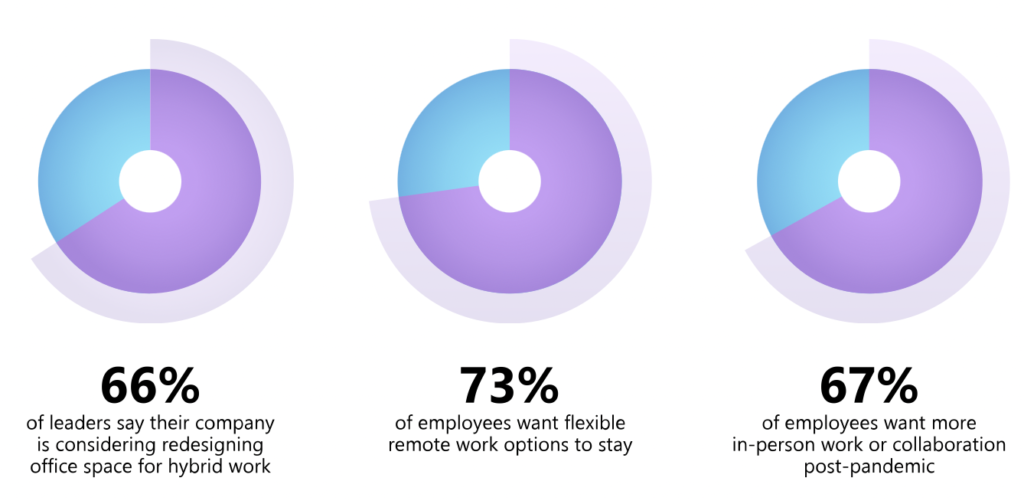Hybrid Working Policy:
How you can prepare for the future?
“Over the past year, no area has undergone more rapid transformation than the way we work. Employee expectations are changing, and we will need to define productivity much more broadly… all this needs to be done with flexibility in when, where, and how people work.” - Satya Nadella, CEO at Microsoft.
Earlier this year, Microsoft release their own hybrid working policy for their 160,000 + employees globally.
To help other organisations plan their working strategy, they released the 2021 Work Trend Index, which outlined findings from a study of over 30,000 people in 31 countries. They analysed productivity and labour signals across Microsoft and LinkedIn. This study provided some interesting results, which are helpful to shape organisation’s hybrid working strategies. In this article, we identify some of the key trends, and how you can apply these to your hybrid working policy.
Adapting to flexibility is key
There’s no doubt, that in a post pandemic world, workers have an expectation to be able to work more flexibly than before. The study found over 70% of workers want flexible remote work options to continue. As a result, employers need to be able to provide flexible working options, at least for parts of the working week, or else they risk employees looking elsewhere.

Source: Microsoft
If employers are unsure of how best to move forward with incorporating flexible options permanently, sending out a survey will help gage what your staff want most. From this, you’re able to create a strategy which adheres to these requirements.
However, enabling flexibility doesn’t just mean letting your staff work from home. The study also found 42% of employees say they lack essential office supplies at home, and one in 10 don’t have an adequate internet connection to do their job. Therefore, kitting your employees out for when they’re away from the office is equally as important as ensuring in-office supplies are maintained.
Check in with your team
This sounds like an obvious one, however many studies have shown that remote working can lead to feelings of disconnect and disengagement between employees and their organisation. This can result in a lack of employee productivity, motivation, and feelings of a lack of purpose within the organisation.
Studies have also shown, those working remote do on average an additional seven hours per week. This can leave employees feeling burnt out and exhausted. It’s therefore important to check in with teams to ensure they don’t feel stressed or overworked. The most effective way to ensure this is done regularly is to schedule in a set day and time each week where employee check-ins can take place.
“Without hallway conversations, chance encounters, and small talk over coffee, it’s hard to feel connected even to my immediate team, much less build meaningful connections across the company.”
It’s important, that despite colleagues working separately, they don’t feel siloed. People are at their most innovative when they’re working as a team. Therefore, it is important team sessions still take place, even if this is virtual. Sharing ideas and collaborating is not only helpful in encouraging innovation, but also helps employees connect and feel like they’re part of a team.
Refine your remote working hiring process
With increased flexibility in your working strategy, comes more opportunity to access a wider talent pool. According to the study, 46% of remote workers surveyed are planning to move to a new location this year because they can now work remotely. Also, by not requiring employees to be full-time in the office, businesses are no longer limited to candidates within a certain location. This means an increasing choice for new talent.
With a solid hybrid or remote working strategy in place, the process put in place will enable workers with new skills to be integrated within the business, without needing to be physically present in the office.
However, attracting these individuals who are outside of your local radius where you usually scout candidates, requires a different recruitment strategy. Aspects like messaging, and cultural differences may need to be taken into consideration, especially if you’re considering candidates from different countries.
Ensure your social and cultural capital transitions
When companies switch to remote or hybrid working, company culture is often the first thing that gets left behind. Even though company culture can be a major factor in employee motivation, loyalty and overall wellbeing at work.
A classic study by Kotter actually demonstrated that an effective company culture can result in payoffs in revenue growth, retention, stock price and net income.
An effective way to encourage a strong company culture is to ensure transparency between employees and managers, whilst in the office and at home. If staff not in the office feel like they’re missing out, this can result in feelings of resentment and not feeling valued.
It’s important to ensure employees working remotely feel like they have the same opportunities as those in the office. This can be encouraged through creating virtual events like training days, Q&As with members of staff, or just generally social time which employees can have time to catch up and engage about non-related work topics. Ensuring social and cultural aspects are included in both virtual and in-person work styles is vital for a strong hybrid working policy.
If you need help building your remote or hybrid teams, Gibson Watts Global can assist with expanding your business, including managing your recruitment processes and onboarding. Speak to a member of our team today to find out more.
